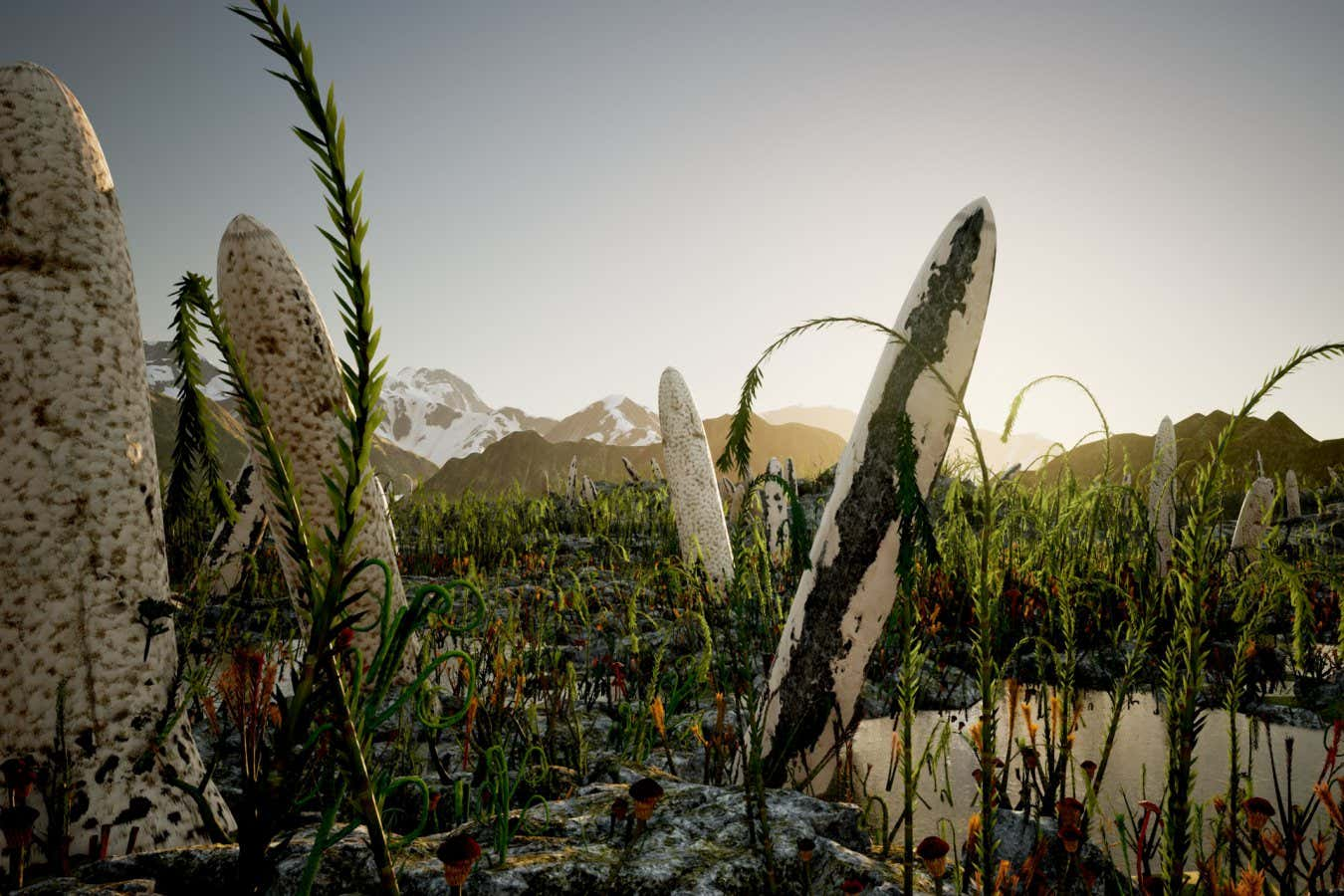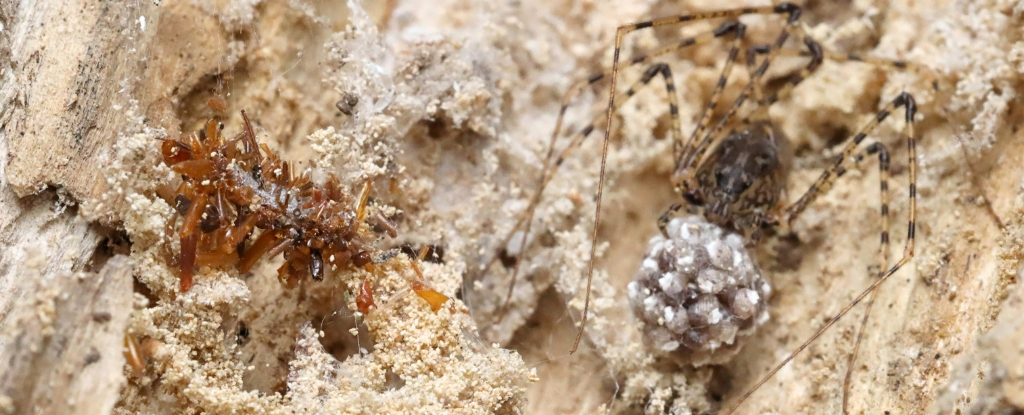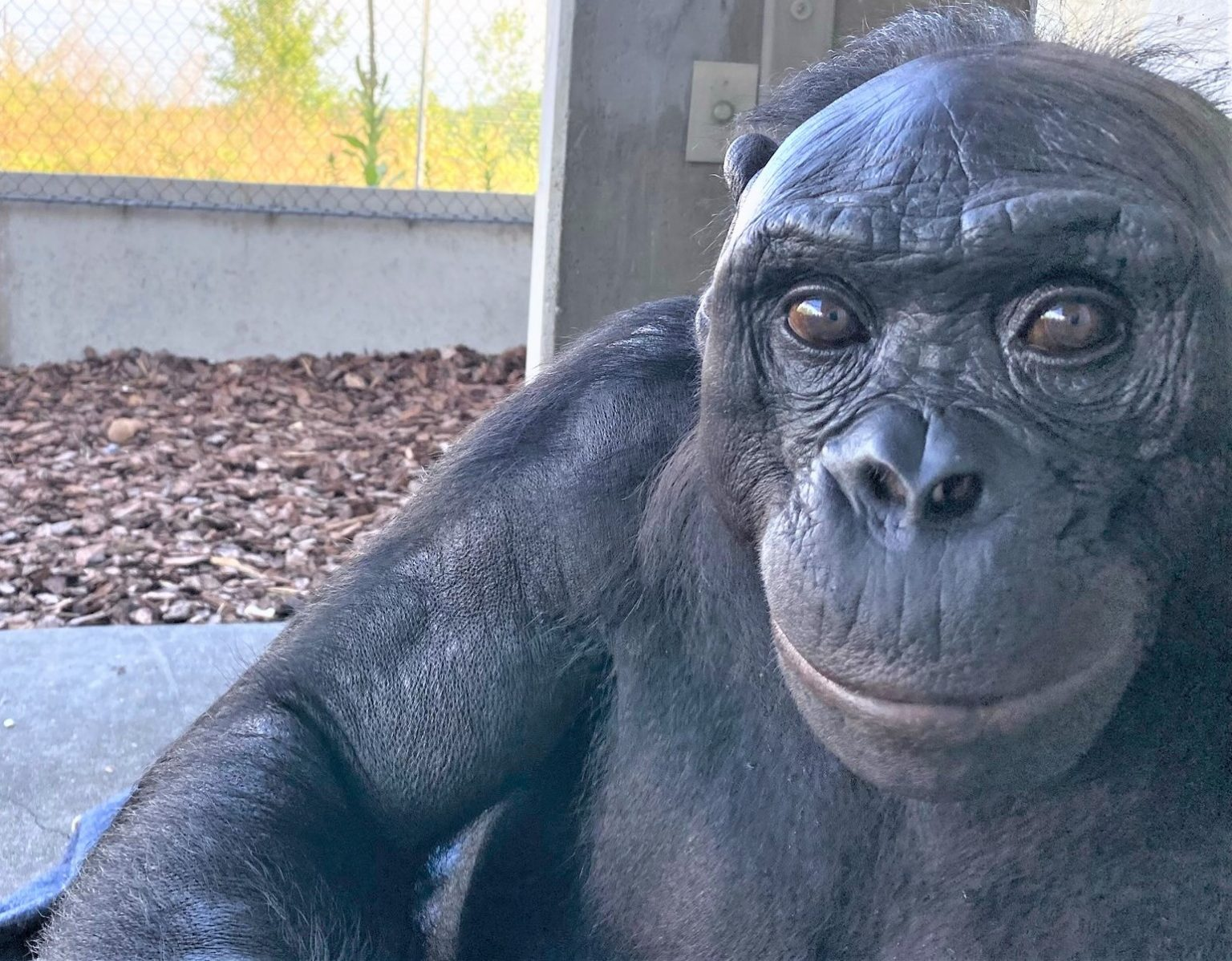Prototaxites, an enigmatic ancient life form, once thrived in the Late Devonian period, reaching extraordinary heights of up to 26 feet. These towering giants are believed to be among the first multicellular organisms to dominate terrestrial landscapes, comprising intricate networks of tiny interlinked tubes. Fossil discoveries, particularly of species like Prototaxites taiti, have spurred ongoing debates about the classification of these extinct eukaryotes and their unique place in the tree of life. Unlike any known fungi or plants, Prototaxites exhibited characteristics distinct from other life forms preserved in significant fossil beds like the Rhynie chert, which offers a glimpse into a world long past. As researchers unravel the complexities of Prototaxites, they shed light on the evolutionary history, leaving us fascinated by the mysteries that these ancient organisms still hold.
Exploring the mysteries of Prototaxites reveals insights into a realm of colossal prehistoric organisms on land. Identified through fossil studies, this ancient entity captures interest due to its bewildering structure and composition, suggesting it diverges from known categories of life such as fungi or plants. The fossil remains exhibit notable features akin to other ancient life forms, igniting discussions about extinct eukaryotic lineages and their ecological roles in ancient environments. Efforts to re-evaluate specimens from sites like the Rhynie chert continue to enhance our understanding of these prehistoric organisms. The revelations surrounding Prototaxites hint at an intriguing puzzle regarding the diversity of life that existed well before our time.
Unveiling Prototaxites: The Mystery of Ancient Eukaryotes
Prototaxites, an enigmatic giant organism from hundreds of millions of years ago, took center stage in the ancient ecosystem. Known for towering as high as 26 feet, these ancient life forms represent a significant piece of Earth’s evolutionary puzzle. Classifying Prototaxites has long posed challenges to scientists, largely because they cannot be easily categorized into established kingdoms of life. Recent studies on the species Prototaxites taiti have shed light on their unique biology, suggesting they belong to a now-extinct lineage of terrestrial eukaryotes, possibly highlighting an unknown branch in the evolutionary tree.
As researchers explore the fossil findings in the famous Rhynie chert, the implications of Prototaxites’ existence become more evident. The study of its anatomical features reveals that Prototaxites had distinct characteristics that set them apart from known fungi, solidifying their mystery within the larger framework of extinct eukaryotes. The fact that these organisms existed millions of years ago, thriving in environments we can only begin to understand, emphasizes the fluidity of life’s classifications and underlines the potential for undiscovered life forms in our planet’s history.
The Role of Prototaxites in Early Devonian Ecosystems
The significance of Prototaxites extends beyond mere classification; they were crucial components of their ecosystems, playing roles not yet fully understood. Given their massive size and structural complexity, Prototaxites likely contributed to the architecture of Early Devonian landscapes, influencing the development of other life forms. As researchers from the University of Edinburgh delve deeper into the anatomy of Prototaxites, they reveal that these ancient organisms shared features with plants, such as lignin compounds, indicating a sophisticated adaptation to terrestrial life, one of the first of its kind.
Moreover, the presence of Prototaxites within the Rhynie chert offers a window into the dynamics of ancient life. This sedimentary deposit, renowned for preserving some of the earliest plant and animal fossils, provides context for how Prototaxites interacted with their environment. They may have competed for resources or provided habitat for smaller organisms, highlighting the complexity of early terrestrial ecosystems. The recent findings challenge us to rethink the roles of various organisms in ancient environments, paving the way for further exploration of their ecological impact.
Dating Prototaxites: Fossil Discoveries and Their Implications
Fossil discoveries, particularly those of Prototaxites and related eukaryotes, have changed our understanding of life’s history on Earth. The Rhynie chert serves as a vital source of information, preserving exquisite details of many organisms from the Early Devonian period. The age of these fossils, around 407 million years, places them at a key transition point where life was becoming increasingly diverse and adapting to terrestrial environments. The discovery of Prototaxites taiti within this remarkable geological formation emphasizes the significance of these ancient organisms and their role in the evolutionary timeline.
As paleontologists continue to unearth new data about Prototaxites, the implications of these findings ripple through our understanding of evolutionary biology. Each new fossil discovery helps to paint a clearer picture of an era when life began to flourish outside the confines of water. The studies on Prototaxites not only illustrate the complexity of ancient ecosystems but also underline the need for further research into extinct eukaryotes, as they may hold keys to understanding the origins of modern biodiversity.
Prototaxites and the Debate on Fungus Classification
The debate surrounding the classification of Prototaxites has spanned over a century, with many scientists previously asserting that these ancient giants were fungi. The recent study led by researchers, including Corentin Loron, has challenged this narrative, affirming that Prototaxites are fundamentally distinct from all known fungal groups. By analyzing the molecular structure of Prototaxites, the team noted the absence of chitin and chitosan, key components of fungal cell walls, leading them to propose a new classification paradigm for these unique organisms.
This discussion is crucial for understanding the diversity of life during the Devonian period. If Prototaxites are indeed a separate lineage, it may indicate that our current classification systems are inadequate and that numerous life forms inhabit branches long unexamined. These findings could open new avenues for scientific exploration into the ancestral roots of multicellular life on land, suggesting that more undiscovered organisms may once have existed, each a testament to life’s adaptability and innovation.
The Evolutionary Significance of Prototaxites
Prototaxites not only encapsulate an evolutionary enigma but also signify a pivotal moment in the transition from simple life forms to complex ecosystems. The study of Prototaxites taiti illustrates that these organisms may have operated on a level of complexity previously unrecognized in early terrestrial life. With defining features that include large tube-like structures and a heterotrophic lifestyle, Prototaxites warrant a closer examination of the evolutionary processes that led to their existence.
Understanding Prototaxites enhances our grasp of the ecological frameworks of ancient environments, potentially offering insights into the origins of modern plants and fungi. By investigating their anatomy and lifestyle, scientists are revisiting the evolutionary trees of life, prompting considerations of previously unknown groups of eukaryotes. Prototaxites not only highlight the diversity of life that once populated Earth but also challenge our definitions and classifications, pushing the boundaries of what we understand about life’s history.
Exploring the Rhynie Chert: A Window to the Past
The Rhynie chert is a geological treasure trove, harboring exquisitely preserved fossils from the Early Devonian period. This unique sedimentary formation has provided key evidence for understanding ancient ecosystems and their inhabitants, including Prototaxites. The presence of this giant organism within the Rhynie chert underscores the site’s importance; it highlights how these ancient life forms coexisted and interacted, sharing an ecosystem that was both complex and dynamic.
Research into the Rhynie chert has revealed critical aspects of ancient terrestrial life, shedding light on the evolutionary adaptations that enabled organisms to thrive in new environments. The fossils found within this formation, including those of Prototaxites, not only demonstrate a rich diversity of species but also suggest collaborative relationships among various life forms. By studying these fossilized remnants, researchers gain invaluable insights into the environmental conditions that shaped early life on land.
The Unique Morphology and Lifestyle of Prototaxites
One of the defining characteristics of Prototaxites is their unique morphology, which sets them apart from both modern and ancient relatives. They consist of large structures with intricate tube-like components, which likely played essential roles in nutrient absorption and structural support. This morphology indicates a sophisticated adaptation to life on land, similar to some vascular plants observed today. Furthermore, the compounds found within Prototaxites, like lignin, hint at analogous functions in rigidity and growth.
The lifestyle of Prototaxites also deviates from typical classifications seen in modern organisms. Described as heterotrophic, these ancient eukaryotes may have relied on consuming other organic materials for sustenance, reflecting an adaptive strategy in their ecosystem. The investigation into their dietary habits encourages a reexamination of ancient life, showcasing how Prototaxites contributed to nutrient cycling in early terrestrial environments, thereby influencing the evolutionary trajectory of life on land.
Revisiting the Tree of Life: The Legacy of Prototaxites
The presence of Prototaxites within the tree of life intrigues biologists, particularly regarding its classification and evolutionary lineage. As research continues, the findings regarding Prototaxites taiti suggest that this organism may represent a wholly unique lineage, which poses significant questions about how we categorize life. If Prototaxites indeed belong to an extinct group of eukaryotes, it could indicate the presence of multiple undiscovered lineages within the evolutionary tree, which broadens our understanding of life’s complexity.
The legacy of Prototaxites may extend beyond mere classification; it raises profound implications about the evolutionary processes that shaped existing biodiversity. As researchers refine our understanding of this ancient organism and its relatives, we may need to reconsider the frameworks by which we comprehend life’s history. Such investigations pave the way for exciting discoveries, challenging long-held assumptions about evolution and encouraging a more nuanced exploration of the intricate web of life on our planet.
Future Directions in Prototaxites Research
As scientific inquiry into Prototaxites continues, future research endeavors promise to unveil even more fascinating insights into these ancient organisms. With advances in fossil analysis and molecular techniques, researchers seek to clarify the ecological roles that Prototaxites played within their habitats. By collaborating across disciplines, scientists aim to refine our understanding of Prototaxites not just as isolated organisms, but as integral components of the terrestrial ecosystems that existed millions of years ago.
Moreover, understanding the evolutionary implications of Prototaxites can influence broader discussions about organism classification and ecology. As more discoveries surface from fossil sites like the Rhynie chert, they will reshape our interpretations of early life on Earth. Through persistent exploration of extinct eukaryotes, subsequent studies will likely reveal new branches of the evolutionary tree, enriching our comprehension of biological diversity and offering compelling narratives about life’s journey across the ages.
Frequently Asked Questions
What are Prototaxites and why are they significant in the study of ancient life forms?
Prototaxites are ancient life forms that thrived on dry land hundreds of millions of years ago, reaching heights of up to 26 feet (8 meters). Their significance lies in their potential classification as the first giant terrestrial eukaryotes, which challenges traditional taxonomy and sheds light on the evolution of multicellular life.
How does Prototaxites taiti differ from modern fungi?
Prototaxites taiti, studied through fossil discoveries, showcases distinct anatomy and molecular composition compared to modern fungi. Researchers found no evidence of chitin in its cell walls, suggesting that P. taiti does not fit into the known fungal lineage, reinforcing its classification as an extinct eukaryote.
What role does the Rhynie chert play in understanding Prototaxites?
The Rhynie chert is a key fossil site from the Early Devonian period that has preserved significant remains of ancient life, including Prototaxites taiti. The anatomical comparisons made with other organisms within the Rhynie chert have been pivotal in determining that Prototaxites had a uniquely distinct structure from fungi and indicates an entirely separate lineage of eukaryotes.
What is the current debate surrounding the classification of Prototaxites?
The classification of Prototaxites has sparked heated debate for over a century. While they were once thought to be fungi, new research indicates that Prototaxites, particularly the species P. taiti, belong to an extinct lineage of multicellular terrestrial eukaryotes, suggesting the potential existence of a new kingdom of life.
Why is the study of extinct eukaryotes like Prototaxites important in evolutionary biology?
Studying extinct eukaryotes like Prototaxites is crucial in evolutionary biology because it provides insights into the diversity and complexity of early life on Earth. Prototaxites serves as an example of how different life forms evolved and adapted to terrestrial habitats, ultimately influencing current ecosystems.
What are the defining features of Prototaxites as discovered by researchers?
Researchers have identified three defining features of Prototaxites: large structures made up of tube-like components, the presence of lignin-like compounds that provide rigidity, and a heterotrophic lifestyle, meaning they consumed other organisms for sustenance, distinguishing them from other known ancient groups.
How does the research on Prototaxites impact our understanding of ancient ecosystems?
Research on Prototaxites provides a deeper understanding of ancient ecosystems by highlighting the role of large, complex organisms in the Early Devonian period. As a significant component of the Rhynie chert ecosystem, Prototaxites influences our perception of biodiversity and ecological interactions occurring during that time.
What implications does the classification of Prototaxites have for current taxonomy?
The classification of Prototaxites poses implications for current taxonomy by questioning traditional categorizations of life forms. Its potential placement within a previously undiscovered lineage of eukaryotes suggests that our current understanding of life’s evolutionary history may need revising to accommodate these unique organisms.
| Key Features | Details |
|---|---|
| Height | Prototaxites species could reach heights of up to 26 feet (8 meters). |
| Classification Debate | Prototaxites’ classification has been debated for over 150 years, as they do not fit into existing tree of life categories. |
| Possible Lineage | Recent studies suggest they belonged to an extinct lineage of multicellular terrestrial eukaryotes. |
| Anatomy | Prototaxites show distinct anatomy different from known fungi, including lack of chitin and chitosan. |
| Defining Features | They are characterized by large tube-like structures, compounds akin to lignin, and a heterotrophic lifestyle. |
| Potential New Kingdom | The findings suggest the existence of a previously unrecognized kingdom of life, though not explicitly mentioned by researchers. |
Summary
Prototaxites represents a fascinating chapter in the history of life on Earth. These ancient organisms, towering as the first giants on land, challenge our understanding of classification within the tree of life. Recent research reveals that Prototaxites likely belong to an extinct lineage of multicellular eukaryotes, distinct from fungi and other known groups. Their unique characteristics could imply that there may be a new kingdom of life waiting to be acknowledged, highlighting the vast complexity of ancient ecosystems. Understanding Prototaxites not only reshapes our view of evolutionary history but also opens doors to discovering more about Earth’s biological heritage.



